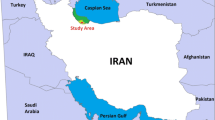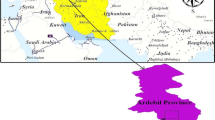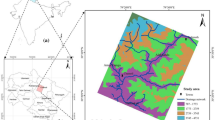Abstract
Kutupalong Rohingya camp is one of the largest humanitarian shelters for conflict-fled people. The camp area is susceptible to landslide hazards because of being situated in dynamic tectonic settings and meteorological conditions. Hence, the study aims to assess the earthquake and rainfall-induced landslide hazards in the camp for the worst-case scenario. The landslide triggering parameters (topographic, soil physical property, and contributing factors) are designed in the study to identify the hazard-prone areas through the factor of safety computation. The topographic parameters are prepared by combining field investigation and remote sensing-based information. The soil physical properties are modeled in two ways to account for their uncertainties: normal probabilistic distribution and interpolation-based spatial distribution. The contributing factors (i.e., earthquake and rainfall) have been assessed using the probabilistic approach. The Peak Ground Acceleration (PGA) exceedance of 50, 75, 100, 200, and 475 years return periods are applied in the factor of safety calculation for earthquake-induced landslides. The rainfall intensities of 50 and 75 years return periods are combined with the PGA exceedance of the respective years to assess the earthquake and rainfall-triggered landslide-prone areas. The factor of safety has been measured following two methods: Monte-Carlo simulation and direct estimation method. Multiple scenarios (rainfall with the duration of 1, 2, and 3 days) are also considered to estimate the landslide-prone areas in these models. The study findings are finally validated against field investigation-based landslide inventory with more than 85% accuracy at a 90% confidence interval.









Similar content being viewed by others
References
Ahmed B (2015) Landslide susceptibility modelling applying user-defined weighting and data-driven statistical techniques in Cox’s Bazar Municipality, Bangladesh. Nat Hazards 79:1707–1737. https://doi.org/10.1007/s11069-015-1922-4
Ahmed B, Rahman MS, Sammonds P et al (2020) Application of geospatial technologies in developing a dynamic landslide early warning system in a humanitarian context: the Rohingya refugee crisis in Cox’s Bazar, Bangladesh. Geomat Nat Hazards Risk 11:446–468. https://doi.org/10.1080/19475705.2020.1730988
Aristizábal E, Garcia EF, Marin RJ et al (2020) Rainfall-intensity effect on landslide hazard assessment due to climate change in north-western Colombian Andes. Rev Fac Ing Univ Antioquia. https://doi.org/10.17533/UDEA.REDIN.20201215
Aziz A (2021) 4 children among 8 killed in Cox’s Bazar landslides. Dhaka Trib
Blaser L, Krüger F, Ohrnberger M, Scherbaum F (2010) Scaling relations of earthquake source parameter estimates with special focus on subduction environment. Bull Seismol Soc Am 100:2914–2926. https://doi.org/10.1785/0120100111
BMD (2021) Bangladesh Meteorological Department. http://live4.bmd.gov.bd/. Accessed 25 Dec 2021
BNBC (2020) Bangladesh National Building Code (BNBC) 2020. House Build Res Inst
Borga M, Dalla Fontana G, Cazorzi F (2002) Analysis of topographic and climatic control on rainfall-triggered shallow landsliding using a quasi-dynamic wetness index. J Hydrol 268:56–71. https://doi.org/10.1016/S0022-1694(02)00118-X
Chisty KU (2014) Landslide in Chittagong City: a perspective on hill cutting. J Bangladesh Inst Plan 7:1–17
Chow VT (1964) Handbook of applied hydrology. McGraw-Hill Book Company, New York
Cunnane C (1978) Unbiased plotting positions—a review. J Hydrol 37:205–222. https://doi.org/10.1016/0022-1694(78)90017-3
Du W, Wang G (2014) Fully probabilistic seismic displacement analysis of spatially distributed slopes using spatially correlated vector intensity measures. Earthq Eng Struct Dyn 43:661–679. https://doi.org/10.1002/EQE.2365
ESRI (2021) Curvature function— ArcGIS for Desktop. https://desktop.arcgis.com/en/arcmap/10.3/manage-data/raster-and-images/curvature-function.htm. Accessed 25 Dec 2021
Factor Geotechnical (2021) What does friction angle of soil mean? https://factorgeo.com/what-does-friction-angle-of-soil-mean/. Accessed 25 Dec 2021
Giiespie M (2021) Kutupalong Chronicles: floods and landslides. In: Chronicles from margins. https://cov19chronicles.com/kutupalong-chronicles-floods-and-landslides-kill-6-rohingya-refugees-and-leave-5-million-homeless-in-coxs-bazaar-bangladesh/. Accessed 25 Dec 2021
Haneberg WC (2004) A rational probabilistic method for spatially distributed landslide hazard assessment. Environ Eng Geosci X:27–43
Haque DME, Kamal DASMM, Rahman A, Bhuiyan MHF (2018) Landslide risk information for KTP Rohingya Refugee camp in Bangladesh. Am Geophys Union, Fall Meet 2018, Abstr #NH52B-10 2018:NH52B-10
Harleman DRF, Mehlhorn PF, RumerJr RR (1963) Dispersion-permeability correlation in porous media. J Hydraul Div 89:67–85. https://doi.org/10.1061/JYCEAJ.0000863
Hossain ATMS, Toll DG (2020) Rainfall induced landslide hazards of Bangladesh: challenges, issues and sustainable development. Int J Sci Eng Res 11:225–230
Hynes Griffin ME, Franklin AG (1984) Rationalizing the seismic coefficient method. Final Report, Miscellaneous Paper No. GL-84-3, U.S. Army Engineer Waterways Experiment Station, Vicksburg, Mississippi
Iida T (1984) A hydrological method of estimation of the topographic effect on the saturated throughflow. Jpn Geomorph Union Trans 5:1–12
ISCG (2018) Risk on flood and landslide for Kutupalong RC|HumanitarianResponse. In: Humanit. Serv. OCHA. https://www.humanitarianresponse.info/ru/operations/bangladesh/infographic/risk-flood-and-landslide-kutupalong-rc. Accessed 25 Dec 2021
Jibson RW (2011) Methods for assessing the stability of slopes during earthquakes—a retrospective. Eng Geol 122:43–50. https://doi.org/10.1016/j.enggeo.2010.09.017
Kamal ASMM (2013) Earthquake risk and reduction approaches in Bangladesh. In: Shaw R et al (ed) Disaster risk reduction approaches in Bangladesh. Japan, pp 103–130
Kramer SL (1996) Geotechnical earthquake engineering, 1st edn. Prentice Hall, Hoboken
Marcuson W (1981) Session 7: moderator’s report. In: International conference on recent advances in geotechnical earthquake engineering and soil dynamics
McClymont A, Bauman P, Miazga C et al (2017) Emergency response groundwater exploration at Rohingya refugee camps in Bangladesh. Can J Explor Geophys 43:12–18
Nguyen VBQ, Kim YT (2020) Rainfall-earthquake-induced landslide hazard prediction by Monte Carlo simulation: a case study of MT. Umyeon in Korea. KSCE J Civ Eng 24:73–86. https://doi.org/10.1007/s12205-020-0963-8
Reliefweb (2018) Rohingya influx overview: key changes during 2018 monsoon season—Bangladesh|ReliefWeb. Cox’s Bazar
Reliefweb (2019) Bangladesh: rohingya face monsoon floods, landslides—Bangladesh|ReliefWeb. In: OCHA Serv. https://reliefweb.int/report/bangladesh/bangladesh-rohingya-face-monsoon-floods-landslides. Accessed 25 Dec 2021
Saulnier GM, Beven K, Obled C (1997) Including spatially variable effective soil depths in TOPMODEL. J Hydrol 202:158–172. https://doi.org/10.1016/S0022-1694(97)00059-0
Seda Ç (2020) Effect of the slope angle and its classification on landslide. Nat Hazards Earth Syst Sci. https://doi.org/10.5194/nhess-2020-87
Seed HB (1979) Considerations in the earthquake-resistant earth and rockfill dams. Gebtechnique 29(29):215–263
Tehrani FS, Hüsken L (2019) Landslide susceptibility mapping of refugee camps in Bangladesh. In: 2nd international conference on natural hazards and infrastructure
Terzaghi K (1950) Mechanism of landslides. Appl Geol Eng Pract. https://doi.org/10.1130/BERKEY.1950.83
Terzaghi RD, Voight B (1979) Karl terzaghi on rockslides: the perspective of a half-century. Dev Geotech Eng 14:111–134. https://doi.org/10.1016/B978-0-444-41508-0.50010-7
UNHCR (2021) Situation refugee response in Bangladesh. https://data2.unhcr.org/en/situations/myanmar_refugees. Accessed 4 Jan 2022
Wang Y, Kerry S (2013) Active tectonic features that pose a seismic threat to Bangladesh. Report of Comprehensive Disaster Management Programme (CDMP)
Wang Y, Sieh K, Tun ST et al (2014) Active tectonic and earthquake Myanmar region. J Geophys Res Solid Earth 119:3576–3822. https://doi.org/10.1002/2013JB010762.Received
Wang JP, François B, Lambert P (2017) Equations for hydraulic conductivity estimation from particle size distribution: a dimensional analysis. Water Resour Res 53:8127–8134. https://doi.org/10.1002/2017WR020888
Wells DL, Coppersmith KJ (1994) New empirical relationships among magnitude, rupture length, rupture width, rupture area, and surface displacement. Bull Seismol Soc Am 84:974–1002
Zhang Y (2015) Stability and run-out analysis of earthquake-induced Landslides. Earthq Eng - From Eng Seismol to Optim Seism Des Eng Struct. https://doi.org/10.5772/59439
Funding
Author Anika Samm-A received the National Science and Technology Fellowship from Ministry of Science and Technology, Bangladesh for this study.
Author information
Authors and Affiliations
Contributions
All authors contributed to the study conception and design. Material preparation, data collection and analysis were performed by AS-A, ASMMK, and MZR. The first draft of the manuscript was written by AS-A, and all authors commented on previous versions of the manuscript. All authors read and approved the final manuscript.
Corresponding author
Ethics declarations
Conflict of interest
The authors declare no competing interest.
Additional information
Publisher's Note
Springer Nature remains neutral with regard to jurisdictional claims in published maps and institutional affiliations.
Appendix 1
Appendix 1

The weight of the block QRST:
where, \(\gamma = {\text{unit weight of soil}}\), H = Thickness of soil.
Height of water table above failure surface = \(h\)
[\(\gamma_{w}\) is the density of water].
Normal component of water weight, \(Pw = \gamma_{w} bh{\text{cos}} \alpha\)
Earthquake loading is expressed as \(kw\), where seismic coefficient, k is multiplied by soil weight \(w\) which is working on the horizontal direction.
Forces perpendicular to slip plane:
Forces parallel to the slip plane:
Rights and permissions
Springer Nature or its licensor (e.g. a society or other partner) holds exclusive rights to this article under a publishing agreement with the author(s) or other rightsholder(s); author self-archiving of the accepted manuscript version of this article is solely governed by the terms of such publishing agreement and applicable law.
About this article
Cite this article
Samm-A, A., Kamal, A.S.M.M. & Rahman, M.Z. Earthquake and rainfall-induced landslide hazard assessment of Kutupalong Rohingya camp using meteorological and geological information. Stoch Environ Res Risk Assess 37, 2777–2789 (2023). https://doi.org/10.1007/s00477-023-02418-z
Accepted:
Published:
Issue Date:
DOI: https://doi.org/10.1007/s00477-023-02418-z




